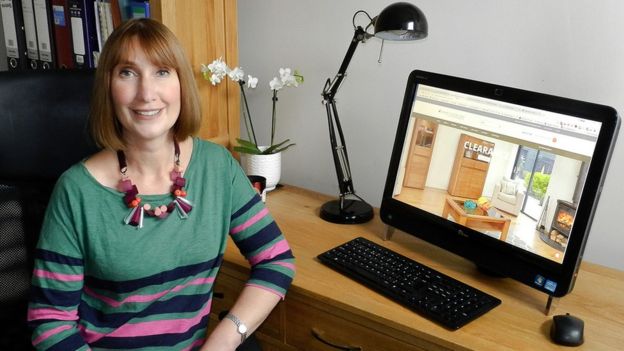 GEOFF PUGH
GEOFF PUGH
What are the best ways to sell online? And how do you make sure you have a website that really works? Part one in our eight-part series exploring all things e-commerce.
Lavinia Davolio makes luxury handmade sweets inspired by her Italian heritage. She says her business received a boost when she opened a store on Amazon's Marketplace.
"It's easy for clients to discover something unique and handmade if it's available through such a trusted online platform," she says.
"And it means we can offer convenient next day delivery at a competitive price and give our boutique confectionary an incredible reach and visibility."
Lavinia is one of thousands of small businesses who've decided to set up shop on an e-commerce marketplace - Amazon, eBay, Etsy, Alibaba's Taobao, Rakuten to name some of the largest - rather than go through the hassles of setting up their own websites.
Amazon charges retailers a 15% commission, but in return even the very smallest entrepreneurs can get a slice of the retail titan's global pulling power just by uploading images and descriptions of their products and then setting their pricing.
For an additional fee, Amazon will store and dispatch your goods - the kind of one-stop convenience that is ideal for newbies, suggests Alan Braithwaite, a visiting professor at Cranfield School of Management.
"Something like Amazon Marketplace is a no-brainer," he says. "Entry costs are very low and straightaway you have a very wide marketplace at your fingertips.
"When you're starting out with your own website you're having to attract the traffic, which means a lot of search engine optimisation [SEO]. This can be complicated and mean extra costs if you need outside help."
Some e-tailers want more creative control over their online shops, however - and to keep more of the sales income for themselves.
Going it alone is certainly a lot cheaper than it used to be, but according to payment processor WorldPay, the average small business spends £2,500 on setting up an e-commerce platform.
At its most basic this will cover product display and listing, navigation structure, a shopping cart facility, search features and secure payment gateways - a checklist that swells with business growth.
DIY website providers such as Wix, Weebly and SquareSpace, help the technical novice with design templates and SEO support from as little as $4.50 (£3.40) a month.
And these days, off-the-shelf "software-as-a-service" add-ons can give a basic website selling and fulfilment functionality that "means you can be online and trading for as little as £500," says Prof Braithwaite.
But "cheap isn't always best," he warns. "It's your front window so it can be worth spending a bit extra - around £5,000 on a developer."
And Clare Jackson, founder of e-tailer The Wooden Furniture Store, points out that you have to be prepared to improve and adapt your website constantly or risk losing sales. You can't pay your set-up fee then sit back and relax.
 THE WOODEN FURNITURE STORE
THE WOODEN FURNITURE STORE
When they discovered that most customers were coming to their website from mobiles, they had to completely rethink the design.
"With mobile users likely to be on slower connections it's crucial to get more speed into the user experience, so we introduced image optimisation and a content delivery network.
"This adapts content to the sizes of screen and devices being used, meaning that the images load much quicker."
A fast website loading speed is crucial for e-commerce success.
Research by application performance company, Apica, finds that 40% of online shoppers refuse to wait more than 10 seconds for a website to respond.
The website change cost just $200 but has contributed to a 500% hike in sales from mobile and a 230% upturn in mobile visitors, says Ms Jackson.
"As a small business, we combine our agility with the kind of technologies which just a few years ago would have been unaffordable for someone our size," she says.
 IFFLEY ROAD
IFFLEY ROAD
Claire Kent and Bill Byrne, the husband-and-wife team behind luxury running wear, Iffley Road, found that replacing their bespoke website with the "easy and intuitive" e-commerce platform, Shopify, made a big difference to their online business.
They liked the fact that they were no longer reliant on a third party but could make changes to the site themselves in minutes.
Ms Kent, a former Morgan Stanley equity analyst who had never used Facebook or Twitter before, and who admits to being "completely untechnical", says she has found analysing customer data surprisingly straightforward using Shopify.
A range of tools gives her data on purchase frequency, customer lifetime value, gross margins and net profit - insights she credits with doubling sales.
"It's like I've suddenly got glasses on whereas before I was blind," she says. "I'd say to anyone that you really need to be looking at analytics every day as you learn so much."
She advises retailers to accept that a website will need to evolve with customers' changing expectations.
"Many SMEs prioritise aesthetics over function; you can have a site that looks amazing but if you don't have the right platform then it just isn't going to deliver."
Listening to feedback and acting on it is also crucial, argues Prof Braithwaite.
"Get friends and families to transact on [your website] and listen to feedback, making sure that payment is secure and seamless is an absolute priority; customers won't come back if this isn't right."
"Fail fast, fail often" may be the mantra amongst the technology giants in Silicon Valley, but it is also apt for online retail entrepreneurs. You have to make mistakes, learn from them, and adapt quickly to achieve success in this global online marketplace.
The next feature will look at the best way to take payments and market your online shop.
from: http://www.bbc.com/news/business-41636026

No comments:
Post a Comment